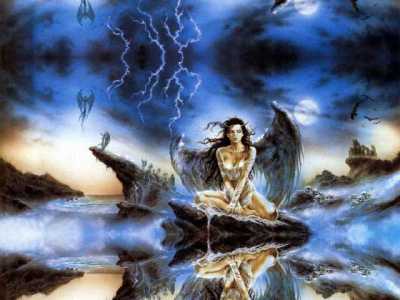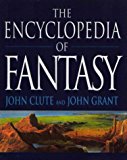Fantasy is probably the most popular of all children’s genres; however much of it is still read and enjoyed by adult readers. One only has to look at the highly successful Harry Potter series to see how much influence this type of writing has. But as a writer you need to be aware of a few facts and conventions of the genre before trying your hand at writing fantasy.

Image courtesy of ginieland
The difference between Science Fiction and Fantasy
Although these genre have much in common, the essential difference is that Science Fiction broadly deals with the ‘theoretically possible’ (although often improbable!) whereas Fantasy deals with the impossible (although that doesn’t mean everything in the story is impossible). Science Fiction takes the existing world to another dimension; Fantasy creates entirely new worlds and infuses them with a degree of familiarity. See for example Terry Pratchett’s ‘Discworld’ fantasy novels. The most recent, Wintersmith, won the British Bookseller’s Children’s Book of the Year (2007).
The difference between Fantasy and Magic Realism
Although some critics place them both in the same basket, strictly speaking, Magic Realism is a genre in which fantasy elements such as magic or the supernatural enter a realistic, natural world without the reader questioning their presence. Clay by David Almond is a good example of Magic Realism.
Fantasy as ‘crossover’
 Long before Harry Potter, adults were secretly enjoying ‘children’s’ literature in the form of fantasy. The Lord of the Rings was originally categorised as a children’s book, as were Orwell’s Animal Farm and Jonathan Swift’s Gulliver’s Travels, even though all three deal with very adult themes. It is really only from the late 1970s and early 80s that fantasy was given its own shelf in the adult section of the library. So is there still a dedicated children’s fantasy genre? I think so. Although it has much in common with adult fantasy (similar plot lines, conventions etc) there are things (common to all children’s writing) that set it apart, such as: child protagonists, age appropriate language, sanitised plot lines (no or limited sex and violence). In addition, The Encyclopedia of Fantasy suggests that what sets children’s fantasy apart is the theme of transformation. This is a fantastical metaphor for the age-old theme of ‘coming of age’ that is found in most children’s writing for the 10+ group. As Lisa Tuttle explains in her Writing Fantasy and Science Fiction:
Long before Harry Potter, adults were secretly enjoying ‘children’s’ literature in the form of fantasy. The Lord of the Rings was originally categorised as a children’s book, as were Orwell’s Animal Farm and Jonathan Swift’s Gulliver’s Travels, even though all three deal with very adult themes. It is really only from the late 1970s and early 80s that fantasy was given its own shelf in the adult section of the library. So is there still a dedicated children’s fantasy genre? I think so. Although it has much in common with adult fantasy (similar plot lines, conventions etc) there are things (common to all children’s writing) that set it apart, such as: child protagonists, age appropriate language, sanitised plot lines (no or limited sex and violence). In addition, The Encyclopedia of Fantasy suggests that what sets children’s fantasy apart is the theme of transformation. This is a fantastical metaphor for the age-old theme of ‘coming of age’ that is found in most children’s writing for the 10+ group. As Lisa Tuttle explains in her Writing Fantasy and Science Fiction:
It is the ability to experience either a transfer of self from place to place or through time, or a change in being (from poverty to riches or from beast to beauty). The latter process is particularly important as it allows the child to come to terms with its own change from child to adult.
(Tuttle, p119)
Common fantasy sub-genre in children’s writing
The Encyclopedia of Fantasy suggests six common sub-genre:
- Worlds in miniature (eg Mary Norton’s The Borrowers)
- Secret gardens and hidden worlds where children can temporarily escape from real life (eg The Lion, the Witch and the Wardrobe, CS Lewis).
- Time fantasies where children travel to another era or encounter ghosts from the past. (eg Madeleine L’Engle’s Time Quartet)
- Otherworlds (secondary worlds such as Tolkien’s Middle Earth or Ursula Le Guin’s Earth Sea)
- Wish fulfilment (Mary Poppins, PL Travers)
- Animal Stories (eg Dick King-Smith’s The Sheep Pig aka Babe!)
General fantasy conventions:
The following are the main conventions you’ll need to be aware of when writing fantasy:
- The fantasy world
- Myths, legends and fairytales
- Magic
- Archetypes
- Landscape with meaning
- Maps
- Journeys
- Suspension of disbelief and internal logic
The fantasy world
Ever since The Lord of the Rings, the stock setting for most fantasy books is a pre-industrial one, with much in common with Earth’s Middle Ages. However, ‘futuristic’ fantasies are becoming more common as the stock setting has been done to death.
Myths, legends and fairytales
Elements of Celtic, Arthurian and Central and Northern European mythology are easily identifiable.
Modern fantasy has its roots in fairy tales, myths and legends – an imaginary past more than a real one. It is therefore less concerned with novelty and innovation than with old stories retold. Even the most inventive and original fantasy tends to look back to earlier epic tradition and what might be considered eternal truths.
(Tuttle, p22)
Magic
This is an almost essential element, as without it, ‘logical’ explanations would have to be found for fantastical events – that would make it Sci Fi, not Fantasy. Critics of Fantasy say that often the ‘magic’ reflects forms of occultic religion, unsuitable for children.
Archetypes
Fantasy is rich ground for Jungian psychologists: the wise old woman, the divine child, the young hero or heroine sent on a quest, helpful animals, a walled castle, the wasteland, the dying king, shape-shifting tricksters, dragons and unicorns. These archetypes have a pre-existing meaning for the reader, and are, to a degree, expected to appear in some form or another.
When they’re handled well, these familiar characters have the ring of truth about them, and seem both familiar and yet original; but if the author is lazy or unskilled they’ll come across as cartoons or clichés.
(Tuttle, p21)
Landscape with meaning
In fantasy, the landscape or ‘world’ that is created has equal importance with character and plot. However, resist the temptation to go overboard on description, and only include as much as is needed to further characterisation and plot.
Maps
Since Tolkien, these have become almost de rigeur in helping your reader to picture the world you have created.
Journeys
Much of fantasy fiction writing has a journey of discovery or ‘quest’ at its heart. We accompany the POV character on his / her journey, and this helps us to navigate through the new world.
Suspension of disbelief and internal logic
When writing fantasy you will expect your reader to suspend their disbelief as they enter your world and take it as you describe it. However, this doesn’t mean that anything goes. Every fantasy world has rules or laws that cannot and should not be broken. Characters need to act within the restraints of these laws. For example, dragons derive energy from the sun and can’t stay on the ground for long (‘Glint’, Ann Coburn, p26). As the creator of this world, you make up its rules, but you too must be subject to them.
A writing exercise:
Create your own fantasy world and write a story set in it. Ask yourself:
- What is the name of your world?
- What does it look like?
- Who lives there?
- Describe a typical child in your world.
- Is the world at peace or at war?
- If at war, who is the enemy?
- If at peace, what threatens that peace?
- Who rules your world?
- What are the ’10 Commandments’ of your world?
- What happens if someone breaks them?
Now write your story.
No related posts.

Writing to me has become a passion to which some find what I write as appalling use of the English language; forget the content of what I write and portray, the wish to entertain those of the same hope as I is enough to keep me going, and alive.
I love fantasy fiction!
I write mostly fantasy/paranormal romance but I would truly love to try my hand at YA or children’s fantasy.
Great article! Thanks so much for posting this.
Hugs,
Tambra Kendal/Keelia Greer
I love articles like this. In a way, they remind me of what NOT to do in fantasy and sci-fi writing. I’m reading Tolkien right now just so that I can see what I have to do to make my work different from his. Of course, some people will look at what I write and automatically think of Tolkien, but most don’t really see that as far as I can tell. I always like to be different and try to be the same with my writing. So thanks for this reminder.
Pingback: Incurable Disease of Writing | Just Write Blog Carnival August 22, 2008 Edition
This is an informative post. I think it has some good ideas, and as said before, has some things to keep in mind when you want to create something different. The idea there is to keep away from the stereotypes.
I have one little thing that bothers me. Parts of your post (mostly towards the beginning) seem to say that most of the fantasy fiction now is still children’s books. I would say that the adult fiction has grown immensely, and is just as big as the children’s fantasy. Sure it gets lumped in with Sci-fi, but the fantasy portion is still large. However, that really is not the main focus on this post. Without thinking of that, the points made here cover both children and adult fantasy.
Thank you for the post.
Thanks Willis. This post was based on a class I taught on wrting for children, so that’s why it’s so biased towards children’s literature. But as you say, the points can apply to adult fantasy as well.
Pingback: The Crafty Writer finds Scordril « Lothian Dragons: Scordril
Wouldn’t future magical realism just be science fiction?
I don’t think so Kylie. In my view SF has to do with the technological aspect not the period (past or present).
The laws and rules associated with magic is something I researched and took a lot of time over when creating my first novel. I had to define the laws of magic in order to prevent someone saying ‘Well if they can do this, this and this why is this obstacle such a great problem. Why can’t they just use magic to solve it?’ In making magic a resource of the land that can be called upon it becomes a limited resource. By also making some people better at calling this power than others it makes for a varied approach to tasks based on which character is confronted with the problem.